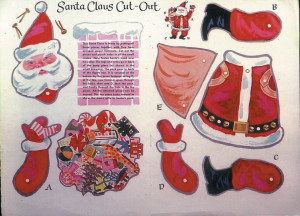Greatly treasured by today’s collectors are the many wonderful paper dolls of the last 150 years. Of all the types available, paper dolls from magazines and newspapers rank among the favorites. Enthusiasm, however, is strongest for Christmas and Santa Claus themes from the printed pages of such popular periodicals as Good Housekeeping, Woman’s Home Companion and Pictorial Review.
December issues of these and other mass circulation publications almost always had Yuletide features on their paper doll pages that were eagerly awaited by the children of subscribing households.
Early on, publishers discovered that Christmas paper dolls helped increase sales, so they always had their illustrators, most of them freelancers like Grace Drayton and Sheila Young, celebrate the holiday season in some special way.
The first American magazine to offer a paper doll within its pages was the November 1859 issue of Godey’s Lady’s Book. Some historians, however, claim the honor for an 1843 Miss Leslie’s Magazine. The Godey’s paper doll series consisted of six boys and six girls, each with clothing depicting the latest fashions for children.
Intermittently over the next 40 years or so, a small number of magazines included a paper doll page. Use of such attractions in Victorian publications did not bring much success, and it wasn’t until the turn of the 20th century that paper doll magazine sheets became popular and abundant. For approximately three to four decades, the magazines of America became the major source of paper dolls of all kinds as each publication strove to outdo the others.
Pictorial Review ran its “Dolly Dingle” series for over 20 years, ending it in 1933. Dolly was a lovable chubby, red-cheeked little girl who, with a multitude of friends and relatives, appeared monthly, often in settings and clothes associated with that month’s holiday. In 1913 there was a “Night Before Christmas” theme, a “Christmas Party” in 1916, and a patriotic “Dolly Dingle Celebrates Her Christmas in True War-Time Style” in 1918.
The Delineator, another leading magazine of the time, introduced Carolyn Chester’s “Adele” in 1912. Five years later, they brought out the fabulous “Who Are They” series of motion picture stars with costumes from their movie roles. The idea was to guess their identity, a difficult job for us today since most of the stars have been forgotten and their films turned to nitrate dust.
Ladies Home Journal serialized “Lettie Lane” from 1908 to 1911 and “Betty Bonnet” from 1915 to 1918. Another series that featured film stars and costumes from their roles was printed by Ladies World Magazine.
In Woman’s Home Companion,” besides Rose O’Neill’s famous “Kewpies,” there was the “Margary May” series drawn by M. Emma Musselman and long billed as “The Companion Paper Doll.” Later, Frances Tipton Hunter did the “Baby Peggy” and “Punch and Judy” paper doll sets for this magazine in the mid-1910s.
Practically every paper doll series in all of these magazines offered holiday topics. Christmas, especially with Santa Claus, was a major highlight.
Many other women’s and children’s magazines featured a serialized paper doll character. All of these sheets are eagerly sought after by collectors today. They are the easiest find of any vintage paper dolls. Unfortunately, untold thousands of fine old magazines have been torn up and discarded in order to salvage the paper doll sheets found in them.
The Sunday newspapers, while not as prolific as the nation’s magazines, offered paper dolls to their readers. In 1895, the first Sunday edition art supplement was introduced in many newspapers and was specifically designed to be attractive to children. In addition to paper dolls, they included games, panorama historical events, and paper toy circuses, theaters, fairy tale characters, and soldiers.
Some of the largest and longest users of these child-oriented, full-color art supplements were the Boston newspapers. The same fierce competition that drove Sunday edition editors to eventually introduce the comic strip also caused them to originate these special supplements.
In 1895 and 1896, the Boston Herald offered, off and on during these years, different paper dolls and wardrobes. Across town, the Boston Globe was the most prolific and their supplements the best. In 1910 they published a series of American historical personalities such as Daniel Boone and Andrew Jackson.
The Globe was the largest producer of Sunday color supplements of any newspaper in the nation. Their total output amounted to over 100 paper dolls sheets alone, running the gamut from George Washington to little children.
In 1921, they printed a series of movie personalities which included Douglas Fairbanks and Mabel Normand. They were immensely popular and are much in demand today. The New York Sunday American, one of the major Hearst newspapers, published “Paper Dolls of Famous Players” in 1911 of celebrated theatrical actors and actresses in their best roles, such as Maude Adams as Chan-ticleer and The Little Minister.
During 1932 and 1933 the St. Louis Dispatch issued full-colored “Movies and Muny Opera Dressographs,” considered by paper doll collectors to be the best newspaper series ever published.
After the 1930s the only paper dolls to be found in the newspapers appeared in comic strip pages where Brenda Starr, Jane Arden, and others were available in five inches by six inches, or so, sized rectangles containing their model and costumes. Invariably, at Christmas time these comic strip women and girls appeared as paper dolls replete with holiday clothing and accessories.
Except for a rare appearance, such as in Good Housekeeping, paper doll magazine pages are a thing of the past which makes them very attractive as a collectible. At this time of the year, when talk is of Santa Claus, decorating trees, and other Yuletide traditions, Christmas collectibles seem extra important and appealing. And none more so than the many holiday-theme paper doll pages from yesterday’s magazines and newspapers.
















Follow Us